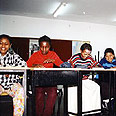

Although global demand for goods and services is expected to rise, the forecast for the rate of increase in 2005 has been lowered recently, partly due to the steep rise in oil prices. It is against this background that the slowdown in Israel’s growth rate should be examined.
The slowdown is reflected in a change in the characteristics of the growth: an increase in domestic consumption and tourism coupled with a decline in exports and unemployment. Inflation remained low, prompting the Bank of Israel to lower its interest rate.
Israel’s rank in the composite world index of globalization has improved. Israel now holds 17th place among 62 countries, mainly due to its high standing in telephone technology, Internet use, and capital transfers. In two other fields, international relations and accords, Israel ranks relatively low.
One encouraging development is the declining unemployment rate - 9.1 percent at the end of the first quarter of 2005 as against 10.9 percent in the same period a year ago. Although the number of unemployed fell from 290,000 in 2004 to 245,000 in 2005, to a large extent the decrease reflected lower rates of labor force participation and only a small part can be credited to an increase in employment.
Unemployment
Furthermore, 70 percent of unemployed Israelis who were hired found only temporary jobs, mostly in the public sector, part-time work, and low-paying positions. Although this kind of employment has questionable stability and quality, it may mark the beginning of a return-to-work process for social groups with low education levels and workers in the Arab sector whose unemployment rate is especially high.
Long-term, differences in unemployment rates between the periphery and central areas have not changed. Although the overall unemployment rate has fallen, unemployment continues to be more widespread in southern and northern Israel than in the center of the country.
With this knowledge, the government has approved a program to stimulate employment in these areas. In areas with especially high unemployment levels, the government will participate in labor costs by paying employers up to 15 percent of their workers’ wages over the next five years. It is intended to extend this program to weaker localities with large ultra-Orthodox or Arab populations.
The Taub Center has continued to address the negative consequences of unemployment in its discussions and annual report, Israel’s Social Services, and has presented several policy options for addressing the issue.
Among other things, the Center recommends the introduction of a negative income tax for low-income groups and proposes more generous unemployment compensation, coupled with the
monitored implementation of programs to return the unemployed to the labor force.
Demographic Developments
On May 12, 2005, Israel celebrated its 57th Independence Day with a population that has grown to 6.9 million. Some 76 percent of Israelis are Jewish and two-thirds of them are native born. Among the Israel born, 1.7 million are second generation Israelis. Among the foreign born, the largest group is made up of 950,000 Soviet and former Soviet Union immigrants.
According to recently published data from the Central Bureau of Statistics, about one-fourth of the population lives in the four major cities - Jerusalem, Tel Aviv-Yafo, Haifa, and Rishon Lezion. The immigration wave of the 1990s contributed to the rapid development of many small cities in Israel. More than one-third of the population of towns such as Ashdod and Ashkelon is made up of people who immigrated within the past 15 years.
Health Care
In Israel, as in other Western countries, the main indicators of population health are improving steadily. Infant mortality is falling and life expectancy is on the rise. The public continued to debate the issue of providing private medical services in public hospitals. On the current agenda is the issue of allowing individuals the choice of hospital for their medical care.
Another issue in the transfer of state health services to the nongovernmental sector is the implementation of a pilot program that reassigns responsibility for local Mother and Infant Care Centers (an efficient state service in preventing disease and monitoring child development) from the Ministry of Health to the Sick Funds.
This step was taken in response to the cutbacks in the government health budget. The physicians’ organizations have protested this step, which they feel will impair the current high level of service.
The privatization of health care services has been discussed widely in the Taub Center’s reports. The Center has warned that, in view of the current state of public health care services and the size of the health budget, there is a risk that expanding private medical services may have a further negative effect on public sector services.
Therefore, it is essential to develop a monitoring and regulatory system before expanding these services.
In this context, the Taub Center recently examined the privatization of geriatric nursing homes. The study found no difference between non-profits and private nursing homes in terms of economic efficiency. The study also reported on the contribution of non-profits to cost-cutting and efficient use of financial resources.
In view of the information and data that it has accumulated, the Taub Center has initiated a series of studies on various aspects of involvement of the governmental and non-governmental sectors in the funding and delivery of social services. Instead of focusing narrowly on the privatization of a specific service, the discussion will explore the principles and tools that are needed for systematic evaluation of the policy on social service delivery in Israel and will address itself to the current - and desired - division of roles among the various sectors.
Immigration
Israel recorded the arrival of 5,400 immigrants from January to April 2005 - a 7 percent increase over the same period in the previous year. The increase is due mainly to a rise in immigration from Ethiopia.
In this context, it is important to note the current debate in Israel regarding the proposed changes in immigration policy: the extension of the Right of Return to family members of immigrants who have converted to Judaism and to members of intermarried families, and the deportation of Israel born children of foreign workers.
The majority of olim from Ethiopia are employed as professional or non-professional workers in industry and agriculture. This raises fears that the group will remain concentrated in the lower social economic levels.
The Joint Distribution Committee and the special project departments of the National Insurance Institute are implementing a program for training and placement of Ethiopian immigrants.
Some 82 percent of the Ethiopian students sat the matriculation exams in 2002. Forty-one percent earned a matriculation certificate and, of those, 36 percent qualified for institutions of higher education.
In 2003, some 1,300 Ethiopian students were studying in universities and colleges
across Israel. There are indications that Ethiopian youth who have been educated in Israel have succeeded in penetrating white-collar businesses.
Focus on Jerusalem
On June 6, Jerusalem Day was commemorated in the capital in large public celebrations. At the end of 2004, Jerusalem had a population of 706,000, some 10 percent of the overall population of Israel. Some 65 percent of Jerusalem residents are Jewish. More than one-third of the inhabitants are children, twice the proportion in the other major cities, Tel Aviv and Haifa.
Conversely, the share of seniors (65+) is lower in Jerusalem than among the population at large. These differences are even more conspicuous among the Arabs of Jerusalem, 42 percent of whom are children and only 3 percent of whom are elderly.
Although the city’s population grew by 13,000 during 2004, Jerusalem has a negative balance of internal migration, meaning that fewer people are moving into the city than are moving out. The population growth is due to natural increase and the arrival of recent immigrants; in 2004, some 2,300 immigrants, 11 percent of all immigrants in that year, chose Jerusalem as their initial residence.
In the long term, the proportion of immigrants from the United States, Canada, and France who have settled in Jerusalem has been rising. Since 1990, nearly 10,000 immigrants from the U.S. and Canada have settled in Jerusalem.
Social
The Ministry of Finance has recently proposed a new economic plan that aims to reduce direct government involvement in guaranteeing citizen’s well-being and to encourage individuals to take personal responsibility for their welfare through labor force participation.
The Ministry of Finance has called its scheme “Compassion and Reason.” The program, among other things, encourages people to join the labor force by offering various benefits for working mothers and the unemployed who return to work.
The idea is to develop public systems for the care of young children during their mothers’ workday and to offer tax relief for the recently unemployed. The plan also includes an increase in benefits for low-income seniors who receive income maintenance.
The program is seen as part of the long-term tax reform plan that proposes to improve the welfare of the middle classes by lowering their tax burden and at the same time raising the tax on capital. The plan aims to improve the situation of low-wage earners, most of whom do not reach the tax threshold, by eventually introducing a negative income tax and by reducing National Insurance contributions and health
tax for this group.
The Taub center experts note that decision makers have lately been talking of turning toward more “socially motivated” policy options. In view of the pressing needs and the cutbacks that have already been made in social service budgets and benefits for the needy over the past few years, it is to hoped that these general statements will be accompanied by the setting of clear and quantifiable social targets (lowering the unemployment rate, reducing the incidence of poverty among children, etc.) and a timetable for progress toward these goals.
'Wisconsin Plan'
Over the past years, there was a massive cutback in transfer payments and a toughening of eligibility terms for most benefits. The implementation of the second part of the “welfare-to-work” program, which aims, in the spirit of the American “Wisconsin Plan,” to return recipients of income maintenance benefits to the labor force is planned to begin in July. For now, a pilot project in four localities is planned.
The adoption of this plan is highly controversial. Its proponents emphasize the importance of moving population groups out of the circle of beneficiaries of income maintenance programs and into the circle of breadwinners.
Opponents note that in Israel National Insurance benefits were cut and eligibility terms were tightened before sufficient steps were taken to help bring benefit recipients back into the labor market, that the cutbacks were drastic and poorly timed, and that implementation was immediate and across the board irrespective of the individual’s actual ability to join the labor force.
When discussing social service policy in the Israeli context, one has to bear in mind the data showing that poverty worsened in 2004. About one-third of children in Israel and one-fourth of those aged 65+ are below the poverty line, single-parent households are under particular stress, and sheltered institutions for the mentally retarded and children in distress are under growing financial pressure of budget cuts and delays that are placing them at risk of closure.
The National Insurance Institute has recently proposed a multi-year program to reduce poverty among children by raising funds from private foundations and businesses. The NII program calls for the setting of objective quantitative targets for the reduction of the extent of poverty among the population.
The Taub Center is Jerusalem is affiliated with the American Jewish Joint Distribution Committee. Report reprinted by permission















